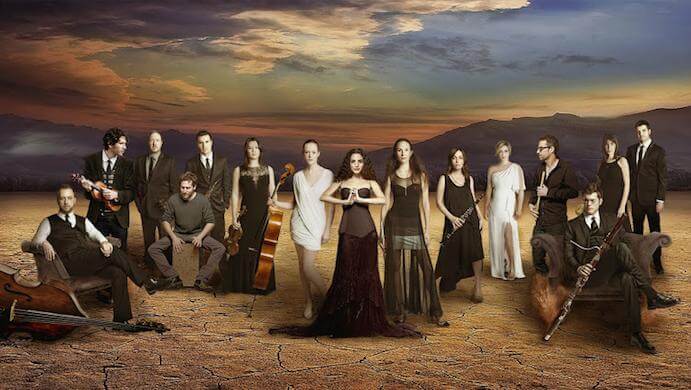There is an old saying that goes something like, “No one is a prophet in their homeland.” In music, cultural exchange and exploration can often provide a rich set of traditions out of which interesting new genres can emerge. With roots and inspiration from the Middle East, Europe, and the Americas, Nedudim, the recent performance project collaboration between Fifth House Ensemble and the Mediterranean folk band Baladino, has precisely this kind of energy. Combining traditions and instruments spanning hundreds of years and thousands of miles in an effort to explore cultural identity and shared experience through music, Nedudim was presented in concert at several venues throughout the Midwest before the ensembles made their way to Concordia University in Ann Arbor, Michigan on April 26, 2015 where I heard the final performance.
Baladino is itself an ensemble that explores cultural intersections and new avenues for expression. They strive to offer fresh and unique interpretations of Jewish Sephardic and Judeo-Spanish melodies, associated with the Ladino language, some of which date back more than a thousand years. Improvisation, electronics, and classical training each have a hand in Baladino’s interpretations of these folk melodies, but their musical versatility does not end there. Members of the group perform on a variety of instruments from different cultures, from the violin and saxophone, to the duduk, shofar, and ney.

Baladino
The goal of a performance or composition that seeks to combine seemingly disparate cultures has the potential to highlight what is unique about each while commenting little on intersections or similarities. Amazingly, Nedudim accomplished both. What’s more, it did so with refinement, a variety of musical styles, and, perhaps most importantly, a performance that was both captivating and moving. Fifth House Ensemble, an accomplished contemporary chamber group out of Chicago in their own right, tossed their cultural experience and musicianship into the proverbial melting pot with Baladino’s, and what emerged was a truly unique and interesting musical statement.
The concert opened with an arrangement of two traditional Ladino folk melodies—Si Veriash a la Rana and Noches noches—arranged for this performance by members of Baladino and Dan Visconti, a composer for Fifth House Ensemble. The arrangement worked perfectly as a concert opener: every performer participated vocally, lending an immersive energy to begin the evening that simultaneously demonstrated the humanism of this cultural exploration. The works that followed were as stylistically varied as one might expect from the project’s description. Black Bend, a pre-existing composition by Visconti that was adapted for the collaboration, featured written and improvised solos that allowed members of both ensembles to bring their musical experience to the table. In Tzur Mishelo–also arranged for the performance by Baladino and Visconti–drones provided by the strings laid a foundation for a beautiful, chant-like melody that weaved between the members of both ensembles. Other works that were collaboratively written and arranged for the performance by Tomer Moked, Visconti, and members of Baladino included La Esklava, Tres Ermanikas Eran, Greek Blues, and Raga Etude. The performance also included a gorgeous arrangement of Robert Beaser‘s He’s Gone Away from Mountain Songs, and “Driving,” a movement from Kenneth Benshoof’s Traveling Music No. 4.

Fifth House Ensemble
Throughout the concert, the adaptations and arrangements seemed natural and effortless—it was often easy to forget that many of these instruments come from different traditions. What’s more, the musicianship that these performers brought to the table made it difficult to believe that the two ensembles had not been performing together for years. One of the most striking ways that they demonstrated this was simply how much they grooved. Baladino and Fifth House found that all-important and ever-elusive musical holy grail we call “groove,” and frequently did so with instruments rarely called on for that purpose. In Tomer Moked’s Greek Blues, for example, the oboe, clarinet, and bassoon all helped to establish a catchy (and bluesy) rhythmic feel, while Grecian scales provided the harmonic and melodic material. Once again, the stylistic mixture worked perfectly; as Clark Carruth—the violist with Fifth House—pointed out after the concert, this work spoke more to the similarities between these two traditions than their differences.
The astounding versatility of these performers was certainly one of the reasons that each of the cultural combinations worked so well. These musicians were so comfortable in every genre and musical language they explored that finding the intersections between them seemed natural and effortless. In all aspects of the performance, down to the childhood stories told between pieces, Baladino and Fifth House inhabited a new musical and cultural landscape that was somewhere between their lived experiences and ancestry. Even more amazing, they did so not with a haphazard mash-up of clearly disparate languages, but with a refined, cohesive, and energetic musical statement that brought the audience to their feet.






















